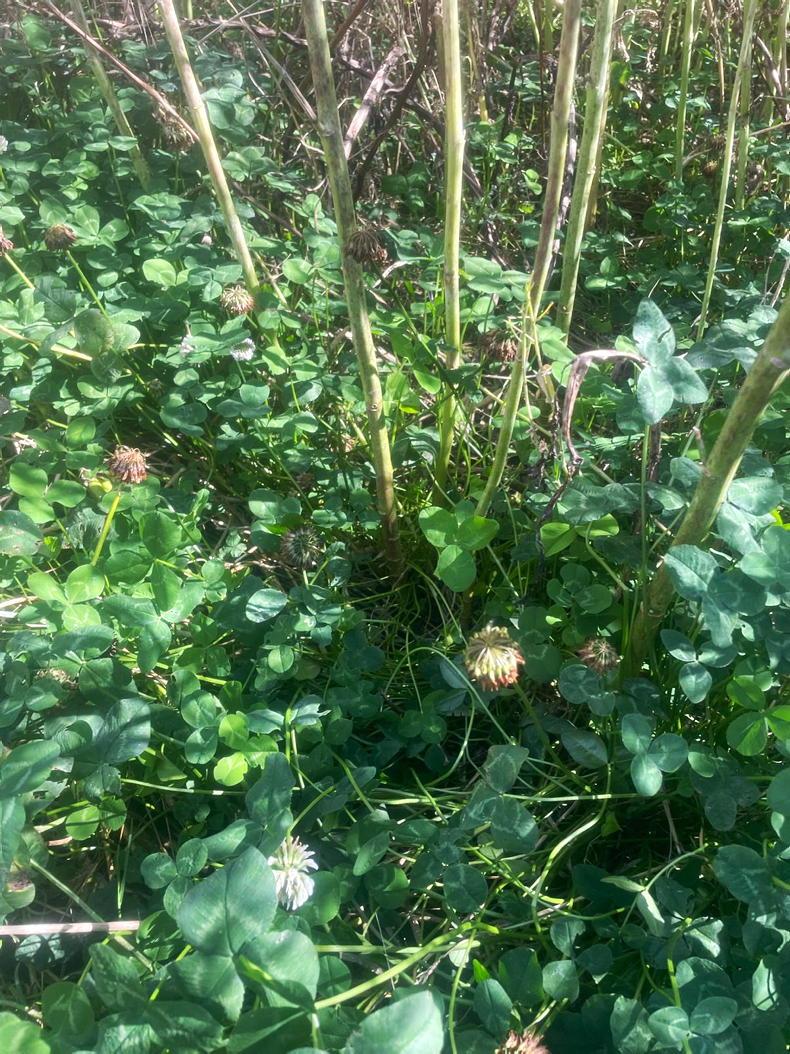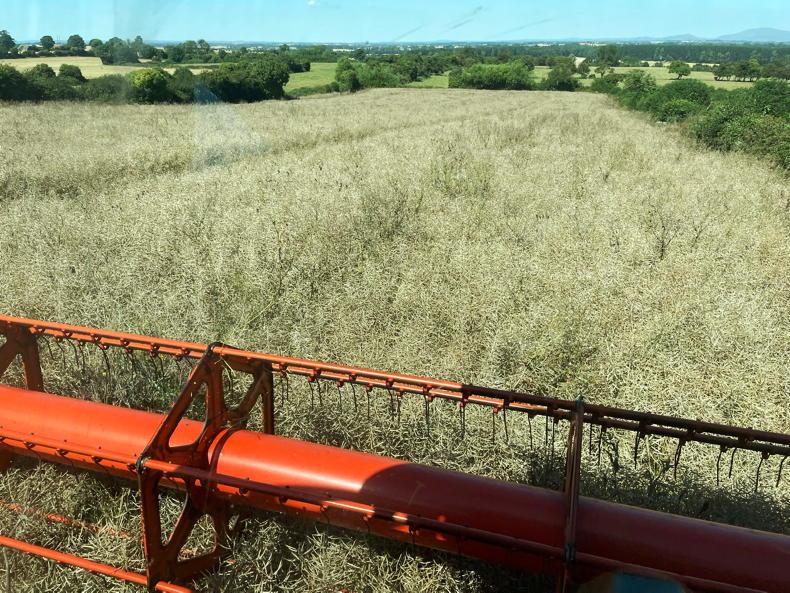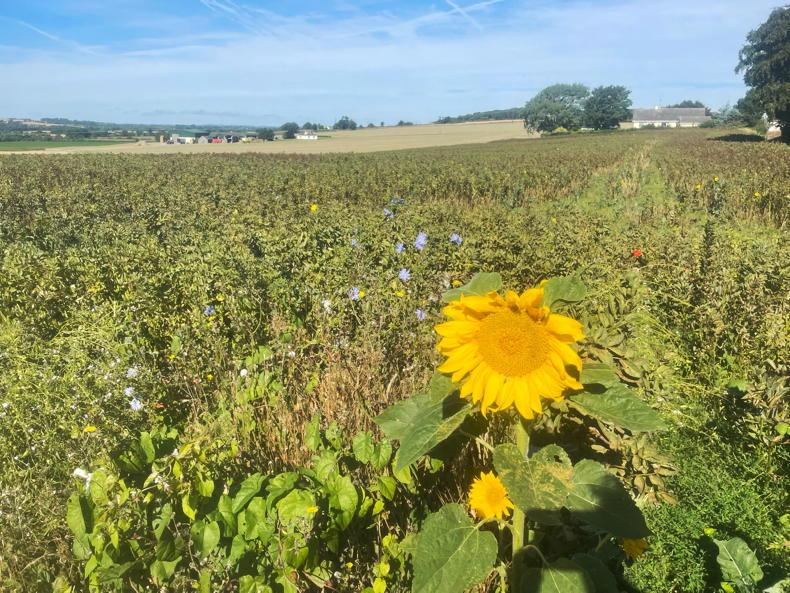Gareth Culligan is almost finished the harvest for 2022. He has a small bit of winter wheat to cut and spring beans will be ready in the coming weeks.
Overall, the Co Louth man is very happy with how crops performed. Gareth tries to implement regenerative farming practices on his farm.
He direct drills his crops, keeps a cover on his soils for as much of the season as possible, and works to reduce artificial fertiliser use and fungicide use.
The winter wheat was one of Gareth’s best crops this year. Most of the crop hit 4.2t/ac. However, one crop was at 2.8t/ac. Before he planted the winter wheat he mixed a number of varieties together.
This can help to stop the spread of disease as one variety could have good resistance to yellow rust and one could have good resistance to septoria and so the spread of disease can be slowed down.
The winter wheat received just one chemical fungicide. This was Folicur to try and prevent rust spread. Other than this four applications of nutrition, seaweed, amino acids, fulvic acid and bitter salts were applied.
Nutrition was also applied in November. The total nitrogen applied to the winter wheat was 140 units/acre, with one crop receiving about 15 units/acre over this.

White clover was planted as a companion crop with the the oilseed rape which was harvested recently. The clover continues to grow.
Many of Gareth’s crops are planted with a companion crop. The lowest-performing of the winter wheat crops had beans and phacelia planted along with it and Gareth thinks he did not apply a herbicide to these crops early enough, which may have affected yield. This is something he will keep an eye on next season.
In total costs on most of Gareth’s winter wheat came to €450-460/ac. An earlier sown block came to approximately €520/ac as there was a companion crop planted. He is very happy with how things turned out this season.

Winter rape being harvested. The crop only received a grass weed herbicide as it was planted with companion crops.
Winter oilseed rape reached 1.75t/ac at 8% moisture content and Gareth said some of the crop was overgrazed by sheep in the winter which most likely affected yield.
Costs amounted to €380/ac including machinery work, a companion crop of sunflowers, buckwheat, beans and white clover, one graminicide, nutrition, seaweed and amino and fulvic acids.
Winter barley was somewhat disappointing, but given the year that was in it the crop did pretty well. Costs amounted to €440/ac.
Cover crops are mostly in on the farm ahead of winter crops. They will soak up nutrients over winter, add diversity to the soil for micro-organisms and worms as well as different rooting depths. Crops like peas will also help to fix nitrogen.

Spring beans planted with companion oats and sunflowers. Some volunteer chicory also grew from the cover crop.
Peas, sunflowers, buckwheat, phacelia and vetch make up the mix, with some volunteer oilseed rape in fields as well. Gareth plans to sow some companion crops with the winter crops as well.
Spring bean crop costs came to €305/ac including machinery work and inputs. It should be noted that no phosphorus or potassium fertiliser was applied as levels are high in the soil.
Winter barley will most likely be planted after the spring beans and as Gareth is direct drilling he will aim to get crops in during September if possible.
Companion crops
Explaining why he plants companion crops Gareth noted: “The idea of growing a companion crop is to get more diversity into the soil, to fix nitrogen and in some cases to help with drainage in the winter time by adding crops like beans.”
This year’s winter wheat was planted in September and Gareth thinks there was more N fixed by the beans because they were sown earlier.
Gareth Culligan is almost finished the harvest for 2022. He has a small bit of winter wheat to cut and spring beans will be ready in the coming weeks.
Overall, the Co Louth man is very happy with how crops performed. Gareth tries to implement regenerative farming practices on his farm.
He direct drills his crops, keeps a cover on his soils for as much of the season as possible, and works to reduce artificial fertiliser use and fungicide use.
The winter wheat was one of Gareth’s best crops this year. Most of the crop hit 4.2t/ac. However, one crop was at 2.8t/ac. Before he planted the winter wheat he mixed a number of varieties together.
This can help to stop the spread of disease as one variety could have good resistance to yellow rust and one could have good resistance to septoria and so the spread of disease can be slowed down.
The winter wheat received just one chemical fungicide. This was Folicur to try and prevent rust spread. Other than this four applications of nutrition, seaweed, amino acids, fulvic acid and bitter salts were applied.
Nutrition was also applied in November. The total nitrogen applied to the winter wheat was 140 units/acre, with one crop receiving about 15 units/acre over this.

White clover was planted as a companion crop with the the oilseed rape which was harvested recently. The clover continues to grow.
Many of Gareth’s crops are planted with a companion crop. The lowest-performing of the winter wheat crops had beans and phacelia planted along with it and Gareth thinks he did not apply a herbicide to these crops early enough, which may have affected yield. This is something he will keep an eye on next season.
In total costs on most of Gareth’s winter wheat came to €450-460/ac. An earlier sown block came to approximately €520/ac as there was a companion crop planted. He is very happy with how things turned out this season.

Winter rape being harvested. The crop only received a grass weed herbicide as it was planted with companion crops.
Winter oilseed rape reached 1.75t/ac at 8% moisture content and Gareth said some of the crop was overgrazed by sheep in the winter which most likely affected yield.
Costs amounted to €380/ac including machinery work, a companion crop of sunflowers, buckwheat, beans and white clover, one graminicide, nutrition, seaweed and amino and fulvic acids.
Winter barley was somewhat disappointing, but given the year that was in it the crop did pretty well. Costs amounted to €440/ac.
Cover crops are mostly in on the farm ahead of winter crops. They will soak up nutrients over winter, add diversity to the soil for micro-organisms and worms as well as different rooting depths. Crops like peas will also help to fix nitrogen.

Spring beans planted with companion oats and sunflowers. Some volunteer chicory also grew from the cover crop.
Peas, sunflowers, buckwheat, phacelia and vetch make up the mix, with some volunteer oilseed rape in fields as well. Gareth plans to sow some companion crops with the winter crops as well.
Spring bean crop costs came to €305/ac including machinery work and inputs. It should be noted that no phosphorus or potassium fertiliser was applied as levels are high in the soil.
Winter barley will most likely be planted after the spring beans and as Gareth is direct drilling he will aim to get crops in during September if possible.
Companion crops
Explaining why he plants companion crops Gareth noted: “The idea of growing a companion crop is to get more diversity into the soil, to fix nitrogen and in some cases to help with drainage in the winter time by adding crops like beans.”
This year’s winter wheat was planted in September and Gareth thinks there was more N fixed by the beans because they were sown earlier.









 This is a subscriber-only article
This is a subscriber-only article










SHARING OPTIONS: